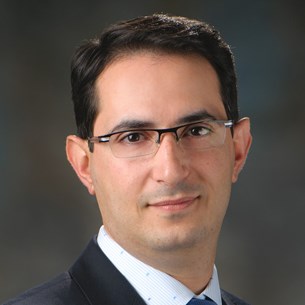Meeting
2023 ASCO Annual Meeting

University of Texas MD Anderson Cancer Center, Houston, TX
Hussein A. Tawbi , F. Stephen Hodi , Evan J. Lipson , Dirk Schadendorf , Paolo Antonio Ascierto , Luis Matamala , Erika Castillo Gutiérrez , Piotr Rutkowski , Helen Gogas , Christopher D. Lao , Juliana Janoski De Menezes , Stéphane Dalle , Ana Maria Arance , Jean-Jacques Grob , Barbara Ratto , Saima Rodriguez , Yuanfang Xu , Sonia Dolfi , Georgina V. Long
Background: In RELATIVITY-047 (NCT03470922), NIVO + RELA demonstrated a statistically significant progression-free survival (PFS) benefit vs NIVO; there was an observed improvement in overall survival (OS) although it was not statistically significant. The combination also had a descriptively higher confirmed objective response rate (ORR) assessed by blinded independent central review (BICR) vs NIVO. Here we report updated descriptive analyses (efficacy, safety, and secondary analyses) with longer (~ 2 years) follow-up. Methods: Patients were randomized 1:1 to receive NIVO 480 mg + RELA 160 mg fixed-dose combination or NIVO 480 mg every 4 weeks, as previously described. Primary endpoint of PFS per RECIST v1.1 was assessed by BICR; secondary endpoints included OS and ORR per BICR. Exploratory analyses were performed for melanoma-specific survival (MSS; defined as death due to melanoma, with censoring of deaths due to other causes) and efficacy outcomes on subsequent systemic therapy. Results: Patients received NIVO + RELA (n = 355) or NIVO (n = 359). Median follow-up was 25.3 months in this updated analysis (minimum follow-up, 21.0 months). NIVO + RELA continued to show a benefit over NIVO for PFS, OS and ORR (Table). A similar improvement was also observed in MSS. NIVO + RELA was generally favored over NIVO across key subgroups (consistent with previous reports). Subsequent systemic therapy was received by 131 (36.9%) and 136 (37.9%) patients in the NIVO + RELA and NIVO arms, respectively. Treatment-related adverse events (TRAEs; any grade) leading to treatment discontinuation were observed in 61 (17.2%) and 31 (8.6%) patients on NIVO + RELA and NIVO, respectively. Grade 3–4 TRAEs were observed in 78 (22.0%) patients on NIVO + RELA and 43 (12.0%) patients on NIVO. In total, there were 6 treatment-related deaths (NIVO + RELA, n = 4; NIVO, n = 2); no new treatment-related deaths have been reported since the last analysis. Conclusions: With 12.3 months of additional follow-up, a consistent benefit was observed with NIVO + RELA vs NIVO for PFS, OS and ORR in the ITT population, as well as in key patient subgroups. MSS was longer with NIVO + RELA compared with NIVO. The safety profile of NIVO + RELA remained consistent with previous reports, with no new or unexpected safety signals. Efficacy outcomes on subsequent systemic therapy (by type of subsequent therapy, including PD-L1/CTLA-4) will be presented. Clinical trial information: NCT03470922.
| NIVO + RELA (n = 355) | NIVO (n = 359) | |
|---|---|---|
| Median PFS, months (95% CI) | 10.2 (6.5–14.8) | 4.6 (3.5–6.5) |
| HR (95% CI) | 0.81 (0.67–0.97) | |
| Median OS, months (95% CI) | NR (31.5–NR) | 33.2 (25.2–45.8) |
| HR (95% CI) | 0.82 (0.67–1.02) | |
| OS rate, % (95% CI) 24 months 36 months 48 months | 61.8 (56.5–66.6) 54.1 (48.6–59.3) 51.5 (45.9–56.9) | 58.3 (52.9–63.2) 48.4 (42.9–53.8) 42.5 (36.4–48.5) |
| ORR, % (95% CI) | 43.7 (38.4–49.0) | 33.7 (28.8–38.9) |
| Median MSS, months (95% CI) | NR (NR–NR) | 46.6 (33.2–NR) |
| HR (95% CI) | 0.77 (0.61–0.97) | |
Disclaimer
This material on this page is ©2024 American Society of Clinical Oncology, all rights reserved. Licensing available upon request. For more information, please contact licensing@asco.org
2023 ASCO Annual Meeting
Oral Abstract Session
Melanoma/Skin Cancers
Melanoma/Skin Cancers
Advanced/Metastatic Disease
NCT03470922
J Clin Oncol 41, 2023 (suppl 16; abstr 9502)
10.1200/JCO.2023.41.16_suppl.9502
9502
Abstract Disclosures
2022 ASCO Annual Meeting
First Author: Hussein A. Tawbi
2023 ASCO Annual Meeting
First Author: Dirk Schadendorf
2023 ASCO Annual Meeting
First Author: Suzanne Phillips
2021 ASCO Annual Meeting
First Author: Evan J. Lipson